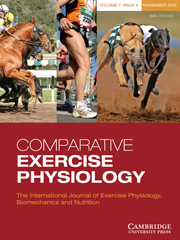Crossref Citations
This article has been cited by the following publications. This list is generated based on data provided by
Crossref.
Clayton, H.M.
2012.
Equine back pain reviewed from a motor control perspective.
Comparative Exercise Physiology,
Vol. 8,
Issue. 3-4,
p.
145.
Walker, V.A.
Dyson, S.J.
and
Murray, R.C.
2013.
Effect of a Pessoa training aid on temporal, linear and angular variables of the working trot.
The Veterinary Journal,
Vol. 198,
Issue. 2,
p.
404.
Stubbs, Narelle Colleen
2015.
Robinson's Current Therapy in Equine Medicine.
p.
101.
Vögele, Anna Magdalena
Zsoldos, Rebeka R.
Krüger, Björn
Licka, Theresia
and
Kellermayer, Miklos S.
2016.
Novel Methods for Surface EMG Analysis and Exploration Based on Multi-Modal Gaussian Mixture Models.
PLOS ONE,
Vol. 11,
Issue. 6,
p.
e0157239.
Valentin, Stephanie
and
Zsoldos, Rebeka R.
2016.
Surface electromyography in animal biomechanics: A systematic review.
Journal of Electromyography and Kinesiology,
Vol. 28,
Issue. ,
p.
167.
Nankervis, Kathryn J.
Launder, Elizabeth J.
and
Murray, Rachel C.
2017.
The Use of Treadmills Within the Rehabilitation of Horses.
Journal of Equine Veterinary Science,
Vol. 53,
Issue. ,
p.
108.
Da Silva, D. A.
Oliveira, K.
Pereira, A. M.
and
Duarte, A. C. A.
2018.
CINÉTICA DO PASSO E DO TROTE DE CAVALOS TREINADOS COM E SEM RÉDEA PESSOA.
Revista Brasileira de Engenharia de Biossistemas,
Vol. 12,
Issue. 3,
p.
228.
Mackechnie-Guire, Russell
Mackechnie-Guire, Erik
Bush, Rosie
Fisher, Diane
Fisher, Mark
and
Weller, Renate
2018.
Local Back Pressure Caused by a Training Roller During Lunging With and Without a Pessoa Training Aid.
Journal of Equine Veterinary Science,
Vol. 67,
Issue. ,
p.
112.
Tabor, Gillian
and
Williams, Jane
2018.
Equine Rehabilitation: A Review of Trunk and Hind Limb Muscle Activity and Exercise Selection.
Journal of Equine Veterinary Science,
Vol. 60,
Issue. ,
p.
97.
Williams, Jane M.
2018.
Electromyography in the Horse: A Useful Technology?.
Journal of Equine Veterinary Science,
Vol. 60,
Issue. ,
p.
43.
De Oliveira, K.
Fachiolli, D. F.
Da Silva, D. A.
Bueno, L. G. F.
and
De Moura, D. J.
2019.
RÉDEAS PESSOA E LATERAL ATIVAM OS MESMOS MÚSCULOS SUPERFICIAIS EM EQUINOS.
Revista Brasileira de Engenharia de Biossistemas,
Vol. 13,
Issue. 2,
p.
116.
Prisk, Amanda J.
and
García‐López, José M.
2019.
Long‐term prognosis for return to athletic function after interspinous ligament desmotomy for treatment of impinging and overriding dorsal spinous processes in horses: 71 cases (2012–2017).
Veterinary Surgery,
Vol. 48,
Issue. 7,
p.
1278.
Muñoz, Ana
Saitua, Aritz
Becero, Mireya
Riber, Cristina
Satué, Katy
Medina, Antonia Sánchez de
Argüelles, David
and
Castejón-Riber, Cristina
2019.
The use of the water treadmill for the rehabilitation of musculoskeletal injuries in the sport horse.
Journal of Veterinary Research,
Vol. 63,
Issue. 3,
p.
439.
Williams, Jane
2020.
Equine training aids: can they really improve performance?.
UK-Vet Equine,
Vol. 4,
Issue. 6,
p.
196.
Ericson, Cajsa
Stenfeldt, Pernilla
Hardeman, Aagje
and
Jacobson, Inger
2020.
The Effect of Kinesiotape on Flexion-Extension of the Thoracolumbar Back in Horses at Trot.
Animals,
Vol. 10,
Issue. 2,
p.
301.
Gehlen, Heidrun
Puhlmann, Julia
Merle, Roswitha
and
Thöne-Reineke, Christa
2021.
Evaluating Horse Owner Expertise and Professional Use of Auxiliary Reins during Horse Riding.
Animals,
Vol. 11,
Issue. 7,
p.
2146.
Stack, John David
and
Harley, Jessica
2021.
Diagnosis and treatment of sacroiliac joint region pain in horses.
UK-Vet Equine,
Vol. 5,
Issue. 4,
p.
150.
Shaw, Karen
Ursini, Tena
Levine, David
Richards, Jim
and
Adair, Steve
2021.
The Effect of Ground Poles and Elastic Resistance Bands on Longissimus Dorsi and Rectus Abdominus Muscle Activity During Equine Walk and Trot.
Journal of Equine Veterinary Science,
Vol. 107,
Issue. ,
p.
103772.
Ursini, Tena
Shaw, Karen
Levine, David
Richards, Jim
and
Adair, Henry Steve
2022.
Electromyography of the Multifidus Muscle in Horses Trotting During Therapeutic Exercises.
Frontiers in Veterinary Science,
Vol. 9,
Issue. ,
Gómez Lucas, Raquel
Ortiz, Gustavo
and
Troteaga, Carla
2022.
Effectiveness of Neuromuscular Electrical Stimulation and Dynamic Mobilization Exercises on Equine Multifidus Muscle Cross-Sectional Area.
SSRN Electronic Journal ,


